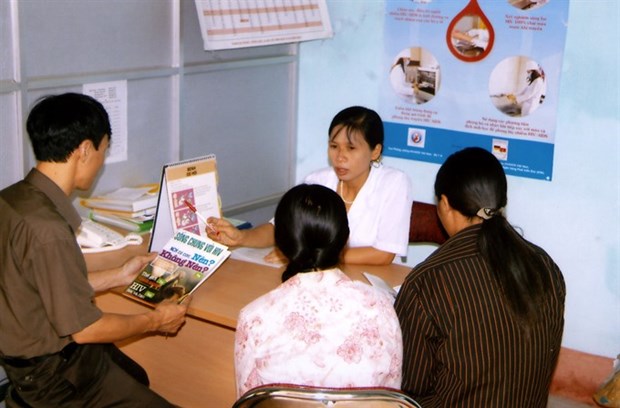 HIV/AIDS patients in Ninh Binh province receive consultations from a doctor (Photo: VNA)
HIV/AIDS patients in Ninh Binh province receive consultations from a doctor (Photo: VNA)Hanoi (VNA) – A Ministry
of Health (MoH) pilot programme to combine tuberculosis and HIV
treatments for TB/HIV co-infected patients in medical centres at district and
commune levels has yielded positive results, experts said.
The programme was first implemented from 2013 to 2015 in Nho Quan district
(Ninh Binh province) and Hung Ha district (Thai Binh province). It was then
expanded to 12 provinces in 2015-2016.
The programme aims to reduce the burdens for ,
caused by separated treatment systems for the two diseases which are common at
most medical establishments in the country.
According to Associate Professor Bui Duc Duong, deputy director of MoH’s
Department for HIV/AIDS Prevention and Control, TB is the most common
opportunistic infection in HIV-infected patients and is thus the leading cause
of HIV death. Every year, Vietnam has about 5,500 new cases of TB/HIV
co-infected patients.
However, an absence of a combined TB/ treatment system has forced many
patients to go back and forth between different medical establishments at the
same time for diagnosis and treatment. For example, a TB-infected patient will
be introduced to a HIV/AIDS-treated centre for test and possible treatment (in
case they are HIV positive). On the contrary, a HIV/AIDS patient who is
suspicious of having TB will be advised to go to a TB-treated centre.
Many patients, already feeling disgraced and hopeless about their situation,
end up quitting the treatment process due to exhaustion.
The pilot programme has solved this problem, said Dr Nguyen Van Cu of the
Central Lung Hospital.
According to the preliminary results from the 12 provinces implementing the
pilot programme, the proactive detection of tuberculosis infection in HIV
patients as well as the detection of HIV infection in TB patients has markedly
improved. Now, patients can be diagnosed for both infections the first time
they go to a medical centre, instead of at least three times as before.
The programme has also increased the number of TB and HIV/AIDS co-infected
patients simultaneously receiving treatment for both diseases.
“The number of patients quitting treatment process has reduced, while doctors
are informed of both TB-treatment and HIV-treatment processes,” Cu said.
The combined model has also helped reduce medical personnel, facility cost and
other investment costs needed to offer TB and HIV/AIDS treatment services, said
Assoc Prof and Dr Le Van Hoi, Deputy Director of the Central Lung Hospital.
Besides, the quality of medical services has improved, especially in disease
detection and early treatment.
Due to the effectiveness of the model, the is ready to
expand the programme to a national scale over the next few years, according to
Hoi.
Several related legislative documents and technical instructions have been
promulgated to prepare for the rollout, including the Framework for combination
of TB and HIV treatment in 2016-2020 and other documents on health insurance
schemes for HIV and TB patients.-VNA
Source: VietnamPlus
